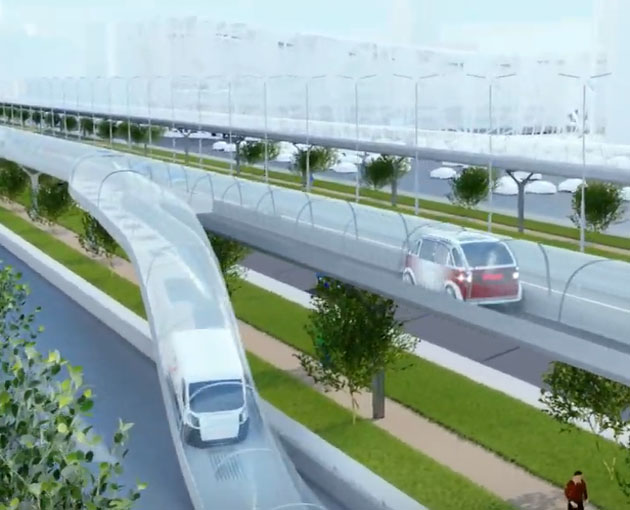Presentation of the solution
BELWAY is a complete mobility solution for urban, suburban and interurban travel.
The model is based on a network of safe lanes dedicated exclusively to autonomous vehicles.
Public transit is provided by a fleet of autonomous electric shuttles that move according to users’ needs.
The network is open to external vehicles such as cabs, delivery vehicles and personal cars.
The whole system is managed by an automatic supervision which guarantees the fluidity of the network at any time for a fast, safe and uninterrupted travel.
A complement and then an alternative to conventional solutions
BELWAY offers a complement to traditional solutions: the end of a tram or metro line, which is less dense than the area currently served, and whose extension is difficult to make profitable.
BELWAY offers the flexibility of its solution, at a controlled cost, with a quality service at all times.
BELWAY can also be a good replacement for a train on a small line that is not used much or any more.
The BELWAY network can then be extended to cover a wider area.

How it works & Features
> A seat for everyone: BELWAY is first and foremost a comfortable public transit system, with autonomous electric shuttles offering 6, 8 or 10 seats, depending on the model.
> Eliminating waiting times: Numerous at peak times, these shuttles are capable of mass transport with a capacity of 30,000 passengers per hour – equivalent to that of an automatic metro, 4 times more than a tramway. In off-peak hours, and outside urban centres, the service is also available continuously: the shuttles wait for users at the station.
Without schedules, they leave within 30 seconds to 3 minutes, only if there are passengers, in order to save energy.
> End-to-end travel in the same vehicle: The same network is able to serve a city centre, its suburbs and even other cities with the same vehicle.
> Dedicated and ligh infrastructure: The BELWAY network is dedicated exclusively to autonomous vehicles: no pedestrians, bikes, or other vehicles. The vehicles travel on the main lanes at speeds of between 50 and 80 miles per hour and access the stations via service lanes, without disrupting the main flow.
Each lane has a capacity of 6,000 vehicles per hour, more than three times that of a motorway lane.
The infrastructure is of lightweight construction, with no new right of way, and can be on land, underground or above ground.
> Intelligent automatic supervision to guarantee permanent availability of the service, the fluidity of the network and the safety of passengers:
Users choose their destination thanks to an ergonomic interface that assigns them a nearby shuttle.
The supervision system optimises the filling of the shuttles by limiting the number of stops, and gives departure instructions in less than 3 minutes.
On the fast lane, the vehicles all travel at the same speed, regulated by the same supervision, which guarantees the permanent fluidity of the network.
Finally, visual interfaces allow the operators in the control room to ensure that the system is working properly and that passengers are safe.
 > A network that can be opened up to external vehicles: Thanks to lane sharing in autonomous mode, the BELWAY network can be opened up to individual passenger transport (taxis, personal vehicles), goods transport and the circulation of professional vehicles (craftsmen, service companies, etc.).
> A network that can be opened up to external vehicles: Thanks to lane sharing in autonomous mode, the BELWAY network can be opened up to individual passenger transport (taxis, personal vehicles), goods transport and the circulation of professional vehicles (craftsmen, service companies, etc.).
BELWAY is already ready for the robot taxis of tomorrow.
The introduction of toll-type network access fees opens up new potential sources of revenue for the local authority.
The detailed benefits
For the planet
> Sustainable : no toxic pollution (NOx, particulate matter), no CO2 emissions during use
> Energy & material efficient: vehicles are light and only move if there is demand
> Decarbonisation by reducing the number of vehicles on the road
> First positive energy transport solution with solar panels
> Resource efficient in construction
> No new footprint
For the community
> An efficient alternative to personal vehicles
> Easily adaptable to everyday and long-term demand : capacity, extension, etc.
> Low investment: infrastructure and light vehicles
> Low operating costs
> Can be financed by concession and amortised by tolls
> Compatibility with level 5 autonomous vehicles.
For the user
> Continuous shuttle service, no schedules, no waiting.
> Greatly reduced travel time: the shuttle leaves within 3 minutes and without unnecessary stops
> End-to-end travel without change,
> Shuttles with 6 to 10 comfortable seats
> Safe travel
